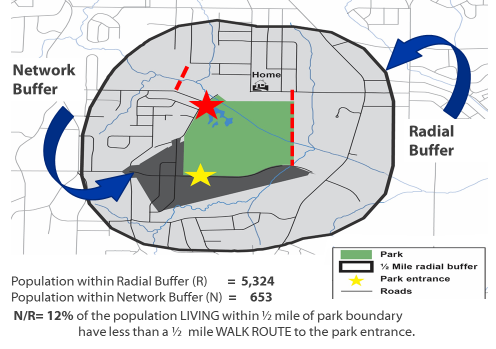Measuring Walking Access to Parks
The US Surgeon General’s 2015 report Step It Up! The Surgeon General’s Call to Action to Promote Walking and Walkable Communities notes that just 22 minutes a day of physical activity such as brisk walking may improve your health. The report goes on to recommend creating desirable destinations, such as parks, that are close to home and connected by well-maintained sidewalks and pedestrian-friendly streets.
Why focus on improving walking routes to parks? In addition to being good for you, walking is an option that is available to most people. If people can walk to a park, then they can likely ride a bike or drive there. However, the opposite is not true. Distributing parks based on biking or driving distances excludes regular access for many people and reduces the health benefits provided by parks when they are walking destinations. Measuring walking access to parks is a good starting point to link parks with public health goals.
In this blog, I explain how to use three population measurements to help park advocates develop data about walking access to parks. These data can be used by park advocates, planning officials, and public health agencies to identify opportunities that increase walking access to parks, evaluate and track a community’s progress over time, and provide a basis for collaboration in developing and supporting strategies to address problem areas.
Follow these steps to measure and track walking access to parks:
1. To measure park proximity in relation to where people live, determine the percentage of the population in the designated area living within a half mile of a park boundary. This measure uses a radial buffer around the park boundary (see illustration, below).
CDC’s National Environmental Public Health Tracking Network (NEPHTN) provides this “access to parks” measure for states and counties in the Community Design content area. Although living close to a park is necessary for walking access, walk routes can be much longer than the straight line distance. Barriers might impede walking directly to a park.

2. To determine walking access to parks more precisely, report the percentage of the population living within a half-mile walk route to a park entrance. This measure uses a network buffer or the “network” of potential walk routes originating from park entrances (see illustration).
This measure requires inventories of park entrances and the walk routes to them. These inventories are impractical for large study areas such as states. Local transportation departments might have existing inventories of sidewalks and street crossings, while local parks and recreation departments might have information on park entrances and boundaries. If these data are not available, park entrances and walk routes can be identified using aerial photographs with field checks to verify questionable sites. You can then use Geographic Information Systems (GIS) software to create half-mile network buffers for parks and estimate the population living within the network buffer based on US census data.
3. To identify individual parks that are not well connected to surrounding neighborhoods, divide measure 2 (walking access) by measure 1 (park proximity) to determine the percentage of the population living within a half mile of a park who have less than a half-mile walk route to a park entrance (see illustration, above).
When this ratio is low, walking access to the park might be increased by:
- Adding an entrance along the park boundary
- Acquiring property that connects the park to a subdivision street
- Removing a barrier (for example, by making an intersection safer to cross or adding sidewalks)
- Connecting streets and eliminating gaps in the street network
- Installing a block cut-through that creates a shorter, more direct route
Park departments, public health agencies, and planning organizations can collaborate to:
- Identify and map lands with important values, such as historic sites and flood plains, to create aspirational park system plans
- Establish goals to improve park access
- Locate parks near people, especially underserved communities with the least access to existing parks
- Make parks more visible and accessible
- Connect parks and homes with pedestrian-friendly streets
- Implement planning reviews and incentives designed to improve walking infrastructure
Data about walking access to parks are useful in identifying locations where new parks are needed, improving park access, and supporting cross-agency partnerships. Measuring walking access to parks is a critical step toward making walking to a nearby park easier for everyone. Improving walking access to parks can have a positive impact on individual and community health.
Figure 1: Illustration of Radial and Network Buffers with Strategies to Increase Walking Access: An analysis of how many people can actually walk to a park provides local partners with a powerful tool. This analysis identifies barriers to walking access and provides direction for mitigating access problems. Note the red symbols which illustrate strategies for improving access, such as a new entrance point, a path linking disconnected streets, and a new street along the park’s edge.